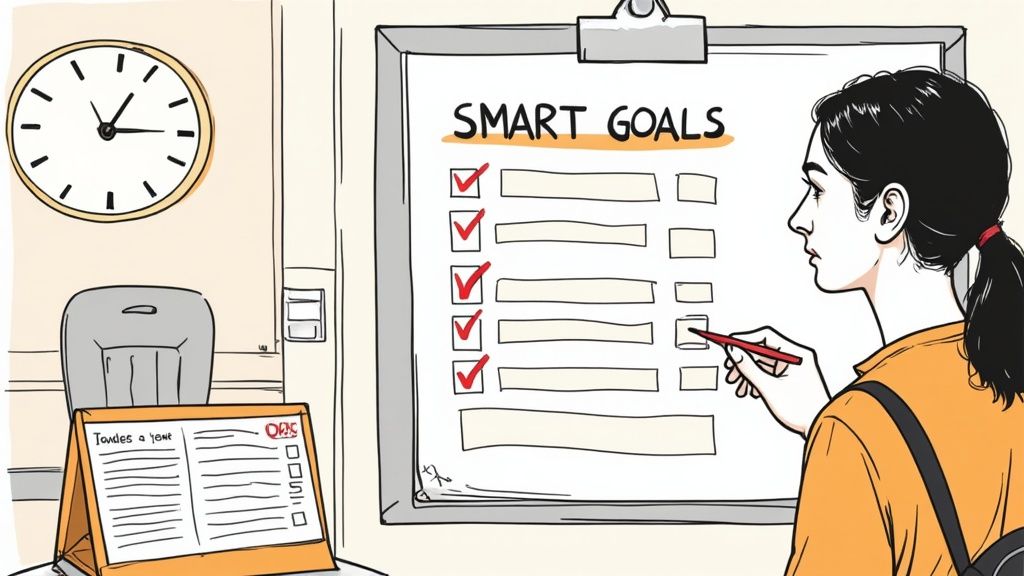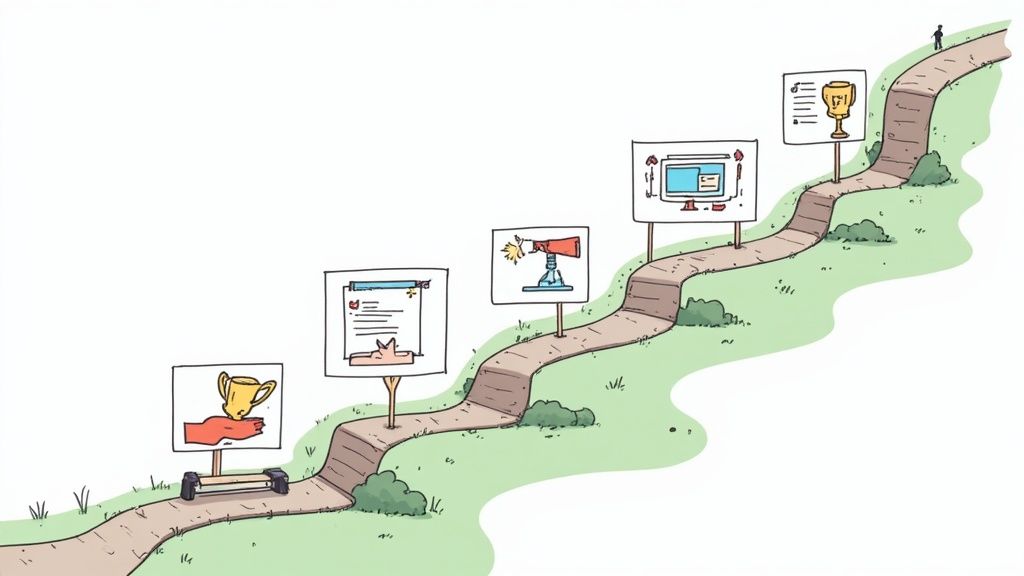Simple SMART Goals Template for Students: Your Complete Guide to Academic Success
Transform your academic journey with our comprehensive SMART goals template for students. Learn expert strategies to create, track and achieve meaningful educational objectives that drive lasting results. meta t: Simple SMART Goals Template for Students: Your Complete Guide to Academic Success published: No slug: smart-goals-template-for-students
Understanding SMART Goals That Drive Real Results
Clear goal-setting is key for students to excel in their studies. Many students start with good intentions but struggle to turn vague wishes like "I want better grades" into real progress. The SMART method provides a practical solution by creating goals that are Specific, Measurable, Achievable, Relevant, and Time-bound.
Why SMART Goals Work for Students
SMART goals take big academic dreams and break them into concrete steps you can actually follow. Instead of saying "I need to study more," a SMART goal would be: "I will improve my Spanish grade from a C+ to a B by spending 30 minutes each day reviewing vocabulary and completing one practice conversation exercise before my next test in 3 weeks."
Research shows that students who use SMART goals tend to develop a growth mindset and see better grades. A study found that specific goals like "Complete all calculus homework assignments 2 days before they're due and attend office hours weekly to review difficult concepts" led to higher success rates than general goals.
Learn more about SMART goals for students
Breaking Down the SMART Framework
Here's what each letter means and how to apply it:
Specific: Write exactly what you want to achieve - which class, what grade, what actions
Measurable: Include numbers and clear ways to track progress - test scores, completed assignments, study hours
Achievable: Set challenging but realistic goals based on your current level and available time
Relevant: Choose goals that matter for your bigger plans - career preparation, graduation requirements
Time-bound: Set clear deadlines - by midterms, end of semester, before spring break
The Psychology Behind Effective Goal-Setting
SMART goals work because they tap into how our brains process success and motivation. When you can measure your progress - like seeing your quiz scores improve or checking off completed study sessions - it creates a positive feedback loop. This visible progress keeps you motivated and builds confidence.
Students who can track their advancement are more likely to stick with their study plans and push through challenges. The clear structure of SMART goals helps especially if you sometimes struggle with procrastination or staying organized.
Building Your Personalized SMART Goals Template
Setting academic goals becomes much more effective when you create a SMART goals template that matches your unique needs. When you design a template that fits your learning style and academic goals, you'll find it easier to stay motivated and track your progress.
Essential Components of a High-Impact Template
Your SMART goals template should help guide you through each step of reaching your goals. Here are the key elements to include:
Goal Category: Choose what you want to focus on - whether it's academics, clubs, or personal growth
SMART Breakdown: Create sections for each part: Specific, Measurable, Achievable, Relevant, and Time-bound
Action Plan: List the exact steps you'll take to reach your goal
Progress Tracker: Add a visual way to see how far you've come, like a simple checklist or calendar
Obstacles & Solutions: Think ahead about what might get in your way and plan how to handle it
Review & Adjustment: Leave room to check your progress and change course if needed
Adapting Your Template for Different Subjects
Each subject needs its own approach. For math, you might focus on mastering specific concepts by certain dates. In writing classes, you could set deadlines for drafts and revisions. By adjusting your template for each class, you create practical plans that match the workload and learning style needed for that subject.
Making the Most of Digital Tools

While paper planners work well for some students, digital tools can make tracking goals easier and more engaging. Using apps and spreadsheets helps you see your progress clearly and set helpful reminders. Research shows SMART goals really work - for example, schools using them have seen 85% of students reach proficient levels in math testing. Learn more about setting measurable goals here: Learn more about measurable goals
Examples of Student SMART Goals Templates
Different learning styles need different templates. Here are some examples:
The Visual Learner: Uses colors and pictures to track progress
The Organized Planner: Creates detailed lists with clear deadlines
The Team Player: Shares goals with study buddies to stay accountable
By choosing the elements that work best for you, you'll build a template that helps you succeed in school. When your template matches your style, you'll feel more in control of your learning journey.
Crafting Academic Goals That Transform Performance

Setting powerful academic goals takes more than just writing down what you want to achieve. The SMART goals template for students helps turn fuzzy ideas into clear action steps. Instead of vague goals like "get better grades," you'll define exactly what grade you want in each class and outline specific steps to achieve it. This clarity helps students stick with their goals long-term.
Identifying Meaningful Objectives
Top students know that real learning goes beyond grades. They focus on truly understanding concepts rather than just memorizing for tests. For instance, in math class, they work to grasp the logic behind formulas instead of just cramming equations. They also make time for sports, clubs, and other activities by carefully planning their schedule to prevent getting overwhelmed.
Overcoming Common Goal-Setting Pitfalls
Students often face challenges like putting off work, losing motivation, and feeling swamped with assignments. The key is breaking big projects into smaller chunks. When that 20-page paper feels impossible, successful students tackle it one section at a time. They also stay flexible - if they get sick or have a family emergency, they adjust their timeline rather than giving up completely.
Transforming Ambitions Into Daily Actions
A smart goals template for students helps map out the path from where you are to where you want to be. Each small task becomes a stepping stone toward your bigger goals. This steady progress builds confidence and momentum. Schools are catching on too - for example, Kentucky teachers now use SMART goals to support their school improvement plans. Learn more about Kentucky's SMART goals approach
Aligning With Your Academic Vision
Your smart goals template for students should fit your unique situation. Think about what you're good at, where you struggle, and what you want to achieve long-term. Maybe you excel at writing but need extra time for math homework. Or perhaps you're aiming for a specific college program that requires certain grades. When your goals match your personal vision, you're much more likely to follow through and succeed.
Mastering Progress Tracking and Achievement Metrics
Your success with goal setting depends heavily on how well you track your progress. Rather than just writing down goals, implement clear monitoring methods to understand exactly where you stand and what you need to do next.
Choosing the Right Tracking System
Every student learns and organizes differently, so your tracking approach should match your style. Some thrive with paper planners, while others prefer digital tools - there's no universal solution. Visual learners often benefit from color-coded charts showing their progress. Detail-focused students may prefer spreadsheets to record specific metrics. Many find that combining physical and digital methods works best - getting the satisfaction of crossing items off a physical list while using apps for reminders and data visualization.
Setting Meaningful Milestones and Adapting to Change
Break down big goals into smaller milestones that you can realistically achieve. These act as checkpoints to keep you on track. For example, when writing a 20-page research paper, set specific targets like:
Complete literature review by week 3
Draft introduction and methodology by week 5
Finish results section by week 7
Complete editing by week 9
This approach makes large projects feel more manageable. Since academic life often brings unexpected changes, build flexibility into your system. Be ready to adjust timelines and goals when needed, without losing sight of your main objectives.
Maintaining Motivation and Celebrating Progress
Regular progress checks help you stay focused, especially during tough academic periods. By reviewing your accomplishments frequently, you'll better understand your learning patterns and identify which study methods work best for you. Take time to celebrate reaching each milestone, no matter how small. These moments of recognition boost your confidence and motivation to keep pushing forward. A positive mindset focused on progress, not perfection, helps maintain steady momentum toward your academic goals.
Overcoming Goal-Setting Obstacles and Roadblocks

Every student faces challenges with academic goals. Let's explore common obstacles and practical ways to overcome them, based on real feedback from students and education experts.
Tackling Procrastination and Motivation Dips
When motivation drops, try the Pomodoro Technique - study in focused 25-minute blocks with short breaks in between. This simple approach makes big tasks feel more manageable. Connect your studies to your bigger life goals too. If you're taking biology classes because you want to help animals as a vet someday, keeping that dream in mind can boost your drive during tough study sessions.
Managing Overwhelming Course Loads
Too many assignments at once? Get organized with a planner or digital calendar to map everything out. Break down big projects into smaller tasks with clear deadlines. Focus your energy on high-priority work first - like that paper due next week before the reading assignment due in two weeks.
Adapting SMART Goals During High-Stress Periods
Life gets messy sometimes. Whether it's getting sick, family stuff, or unexpected events, your carefully planned schedule can get disrupted. That's okay - your SMART goals should be flexible. Adjust deadlines or break goals into smaller pieces when needed, but keep your main objectives in sight. This helps you stay on track even when things don't go as planned.
Building Resilience and Maintaining Focus
Develop a growth mindset - believe that you can get better through effort and practice. When you hit a rough patch, see it as a chance to learn rather than a failure. Stay focused by setting up a quiet study space and using website blockers during study time to avoid social media distractions.
Actionable Frameworks for Adjusting Goals
When life throws you off course, use these steps to get back on track:
Check Reality: Look at how current events affect your available time and energy
Update Timeline: Give yourself more time if needed
Resize Goals: Make goals smaller but still meaningful
Create Mini-Steps: Turn big tasks into smaller, doable chunks
Ask for Help: Talk to teachers, advisors, or classmates when stuck
Using these strategies turns your SMART goals into a practical tool for academic success. This approach helps you handle challenges while keeping your long-term goals in sight.
Real Student Success Stories and Strategic Insights

While a SMART goals template provides a useful framework, real examples show how it works in practice. Let's look at how different students have used SMART goals to improve their academic performance and learn from their experiences.
From Procrastination to Productivity
Maria, a sophomore who struggled with putting off work, changed her study habits using SMART goals. She set this specific goal: "Complete all assigned readings for my history class two days before the lecture for the next four weeks." By breaking down readings into daily segments and tracking them in her planner, Maria stopped procrastinating and understood the material better. Her success gave her the confidence to apply SMART goals to other classes.
Conquering Test Anxiety
David, a junior worried about upcoming exams, used SMART goals to guide his preparation. His goal was clear: "Improve my biology exam score from a C+ to a B by studying one hour daily, reviewing practice questions twice weekly, and attending all review sessions for the next three weeks." Using flashcards and a study schedule to track progress, David's focused approach reduced his anxiety. His hard work paid off with a B+ on the exam.
Balancing Academics and Extracurriculars
Sarah, a senior managing both AP classes and activities, used SMART goals to find balance. She focused on this goal: "Complete all AP Calculus homework by 9 pm each night to participate in debate club meetings without stress for eight weeks." Using a digital calendar with reminders helped Sarah track her progress. This organized approach let her succeed in both her studies and activities.
These examples show how SMART goals help students improve. Setting specific, measurable, achievable, relevant, and time-bound goals - while tracking progress - helps overcome academic challenges. Students learn valuable skills in managing time, building discipline, and bouncing back from setbacks.
Want to boost your own academic success? Obsibrain helps you create and manage SMART goals right in Obsidian. Keep your tasks, habits, and daily plans all in one place. Start reaching your goals with Obsibrain today!
Last updated
Was this helpful?